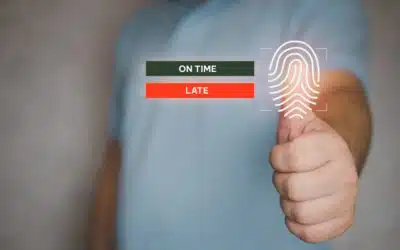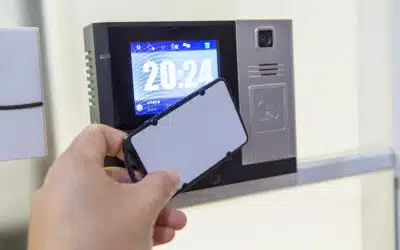The time and attendance arena has lots of jargon, acronyms, abbreviations and technical terms. In our time and attendance glossary, we attempt to list the more regular terms and explain what they mean.
Auto match
In time and attendance systems, this is when the software automatically confirms a shift as being worked based on pre-set parameters. For example, the employee has an 0900-1700 shift and clocks in at 0859 and clocks out at 1702. The auto-match software will recognise this as a correctly worked shift and approve it automatically.
Employee Attendance Tracker
This is software which tracks whether an employee was on time, late, or absent from a shift. It is a term often used to describe the software used to manage time and attendance. Capturing and managing the clock-ins and clock-outs is often part of a workforce management system.
Biometric Identifiers
Physiological characteristics related to the shape of the body and can be used to uniquely identify a person. The biometric identifiers most often used in time and attendance include fingerprints, palm veins, face recognition, palm print and hand geometry.
Biometric Template
An encrypted set of biometric identifiers which have been converted into an algorithm to allow a biometric reader to repeatedly identify the person the template relates to. These are created on a biometric reader and stored for later use, and mapped against an identifying code, such as a staff ID number. A biometric template is not a photo and can only be “read” by a machine which can decrypt the template.
Buddy Punching
This is when one employee asks another person to clock in or out for him when the first employee isn’t present. For example, person A is running late and calls ahead to ask person B to clock them in. It is a form of time fraud.
BYOD
This stands for Bring Your Own Device. In time and attendance, this relates to staff being asked to download an app with either NFC, QR or GPS tracking that can be used to clock in and clock out.
Clock In
To use some kind of clock to record the time you start working: I clocked in at 08:00
Clock Out
To use some kind of clock to record the time you finish working: I clocked out at 17:00
Face Recognition Reader
A form of biometric scanner which uses a person’s unique facial contours to identify them, often as part of a time and attendance system.
Fingerprint Reader
A form of biometric scanner which uses a person’s unique fingerprint to identify them, often as part of a time and attendance system.
Hand Reader
Also called a palm reader, A form of biometric scanner which uses a person’s unique palm print to identify them, often as part of a time and attendance system.
NFC
Near-field communication is a set of communication protocols that enables devices within a few centimetres of each other to exchange information wirelessly. In time and attendance, NFC is often used to clock someone in by matching the known location of an NFC tag (often on a poster on the wall of a shop or other venue) to an employee who has downloaded a Native App that forms part of a time and attendance system. The employee clocks in and out via the App by holding their phone close to the NFC tag and thus proving the employee was in the location at that time.
GPS
The Global Positioning System (GPS) is a navigation system using satellites, a receiver and algorithms to locate someone accurately. In time and attendance GPS is often used to clock someone in by matching the location of the GPS signal to an employee who has downloaded a Native App that forms part of a time and attendance system. The employee clocks in and out via the App, which checks the GPS location is within a few yards of the allowed location (such as a store or other venue) and thus proving the employee was in the location at that time.
Native App
Are those apps that were designed to run on a particular operating system. For instance, mobile phones have either an IOS (Apple) or Android (Google) app. In time and attendance, native apps are written to allow employees to clock in and clock out using either QR codes, GPS or NFC tags to identify their location at the time of clocking in.
Punch In
To use some kind of clock to record the time you start working: I punched in at 08:00
Punch Out
To use some kind of clock to record the time you finish working: I punched out at 17:00
Punch in app
A web or native app-based tool which allows you to punch in
QR Code
A QR code (an initialism for quick response code) is a type of matrix barcode (or two-dimensional barcode) invented in 1994 by the Japanese company Denso Wave. In time and attendance, QR codes are often used to clock someone in by matching the location of the QR code (often on a poster on the wall of a shop or other venue) to an employee who has downloaded a Native App that forms part of a time and attendance system. The employee clocks in and out via the App by scanning the QR code, which triggers the clock-in on the app for the location matched to the QR code. These are at risk of time fraud because employees can copy QR codes and take them home with them.
Time and Attendance
Also called T&A. It is used to track when employees start and stop work. A T&A system enables an employer to monitor their employee’s working hours, lateness, early departures, breaks and absenteeism.
Timekeeping
Refers to the monitoring of employee clock–ins and clock-outs. Modern timekeeping methods are very straightforward, designed to determine the amount of time that employees worked and how much the employee is owed for that work. Keeping track of paid time helps employers develop a clearer picture of their true work costs.
Time fraud
Sometimes called time theft is what happens when an employee intentionally gets paid for the time they did not work.
Time Sheet
A method for recording the amount of a worker’s time spent at work. Traditionally a sheet of paper with the data arranged in a tabular format that employees sign to confirm their hours. Often a timesheet is a digital document or spreadsheet. Within Time and Attendance, these are known to be at risk of time fraud and also often require re-entering into a payroll system if they aren’t embedded into a time and attendance or workforce management system.
Work log
A digital timesheet that is part of a time and attendance or workforce management system. It will usually incorporate clock-in and clock-out data and some form of auto-match functionality. Managers will normally be required to approve a work log at the end of each day, which will include the approval of exceptions such as overtime and sickness, which the auto-match engine is not authorised to approve.




